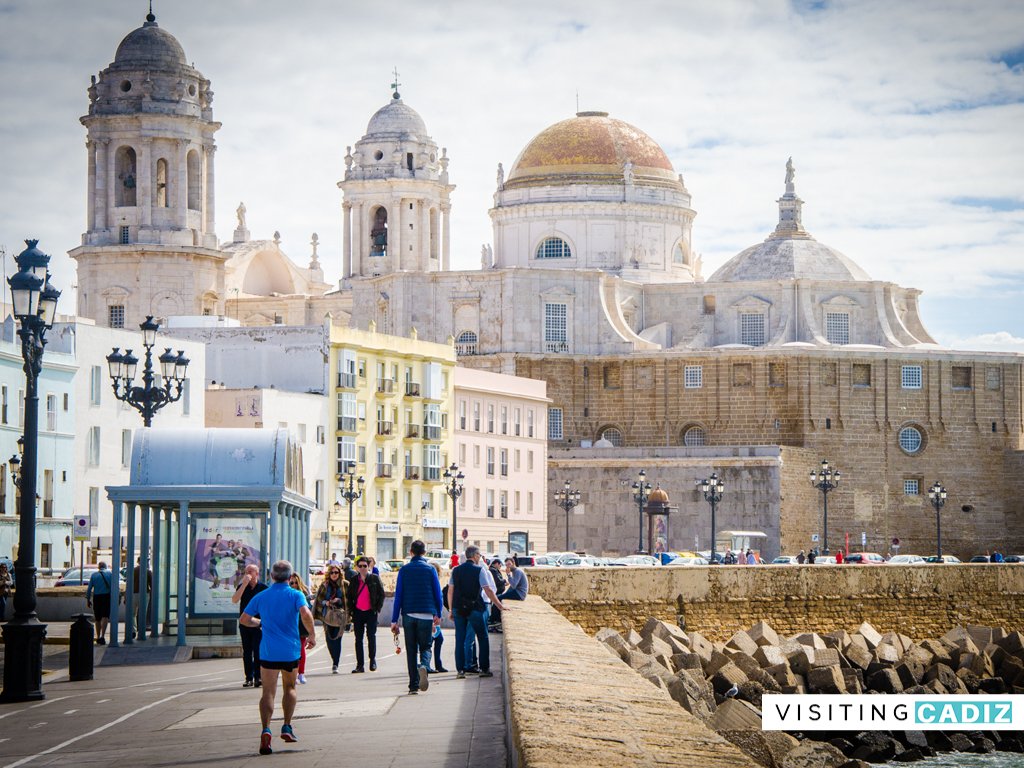During the early years of the18th century, as Cádiz grew wealthy on trade with the Americas and Indies, its was decided to replace the old cathedral (Iglesia Santa Cruz) with a new and more lavish building that reflected the citys riches during this golden age.
The new cathedral was designed by Vicente Acero, construction began in 1722 funded by the wealthy shipping magnates of the city.

Search for guided tours and activities in Cádiz here: https://visitingcadiz.com/guided-tours-and-activities-in-cadiz/
The Audio guided tour of Cádiz

The Cathedral and its plaza is included in the Visit Cádiz audio guided tour. Check it out here: https://visitingcadiz.com/immerse-yourself-in-cadizs-rich-history-a-guided-audio-tour/
Or, just scan the QR code on the left with your mobile phone.
Italian architecture in Spain?
You might be forgiven for thinking that the cathedral has an “Italian” look and feel as the building combines Spanish architectural tradition with Italian Baroque forms. The plans of Gothic origins also coincided with the works of Italian architects at the time. However, the original plans did go through many changes and directions right up to when the ground was consecrated in 1838

The temple is in the shape of a Latin cross and has three naves, an apse and side chapels. The naves are separated by elliptical pillars with fluted Corinthian columns at the ends. The main façade, framed by two large towers that increase its width, is divided into three sections. The central area houses the main entrance made of stunning white marble.
The octagonal towers are made up of three sections: the first in the Baroque style and the other two in the Neoclassical style. The dome, located on the cross, stands out for the yellow color of the glazed tiles, on whose base you will see the sculptures of the four evangelists.
Inside the Cathedral there are 16 chapels with the most interesting being:
- The chapel San Sebastián stands out as it holds a work by the Genoese artist Andrea Ansaldi painted in 1621.
- The chapels of San Servando and San Germán preserve representative baroque sculptures of the owners. made in 1687 they are the work of Luisa Roldán (known as la Roldana).
- The chapel of Santa Teresa holds the tabernacle of the Corpus Christi procession. This was made of silver between 1649 and 1664 by Alejando Saavedra.
- The main chapel has a circular neoclassical temple made of colored marble and gilt bronze, Built in 1790 by Manuel Machuca.

The crypt
The crypt, designed by Vicente Acero was completed in 1726. It is organized around a circular space covered by a flat vault, from which various rooms open. Here we find a rectangular space with niches for burials in which, on the head wall, there is a marble Genoese altar from the 17th century with the image of the Virgin of the Rosary. In addition to the bishops of the diocese, Manuel de Falla and José Maria Pemán, illustrious figures from Cádiz, are also buried in the crypt.
Opening times
- Monday to Saturday from 10:00 a.m. to 8:00 p.m. Last visit at 7:15 p.m.
- Sundays: Cathedral from 1:30 p.m. to 8:00 p.m. and Clock Tower from 12:00 p.m. to 2:30 p.m. and from 3:30 p.m. to 8:00 p.m.
- Mass: Sundays and holidays at 12:00 p.m.
Entry prices
- General: €7 – Pensioners €6, Students (under 25 years) and groups (more than 20 pax) €5 – Children (under 12 years) free. (The entrance ticket also includes a visit to the Clock Tower).
Cádiz Cathedral: Frequently Asked Questions
The cathedral was constructed in the early 18th century to symbolise Cádiz’s prosperity during its “golden age,” when the city flourished through trade with the Americas and the Indies. It replaced the older Iglesia Santa Cruz and was funded by wealthy local shipping magnates eager to reflect their newfound riches.
Architect Vicente Acero designed the new cathedral, and construction began in 1722. The project spanned over a century and was only completed and consecrated in 1838, having gone through multiple design changes over time.
The cathedral combines Spanish architectural tradition with Italian Baroque and Neoclassical influences. It’s shaped like a Latin cross and features three naves, side chapels, and an apse. Inside, you’ll find elliptical pillars, fluted Corinthian columns, and a striking yellow-tiled dome supported by sculptures of the four evangelists. The twin octagonal towers add to its grandeur—lower sections in Baroque style, upper in Neoclassical.
Yes, visitors often comment on its Italian appearance. Though it’s a Spanish cathedral, the use of Italian Baroque forms, evolving Gothic plans, and influence from Italian architects working in Spain at the time give it a distinctly Mediterranean feel.
The cathedral houses 16 chapels, each with artistic and historical value:
San Sebastián Chapel holds a 1621 painting by Genoese artist Andrea Ansaldi.
San Servando and San Germán Chapels feature Baroque sculptures by Luisa Roldán (La Roldana), made in 1687.
Santa Teresa Chapel contains a silver Corpus Christi tabernacle crafted between 1649–1664 by Alejandro Saavedra.
The main chapel includes a circular Neoclassical temple of coloured marble and gilt bronze, built in 1790 by Manuel Machuca.
The crypt, designed by Vicente Acero and finished in 1726, is arranged around a circular chamber with burial niches. It features a 17th-century Genoese marble altar dedicated to the Virgin of the Rosary. Notably, the composer Manuel de Falla and writer José María Pemán are interred here, along with bishops of the diocese.
Monday to Saturday: 10:00 a.m. – 8:00 p.m. (Last entry: 7:15 p.m.)
Sundays:
Cathedral: 1:30 p.m. – 8:00 p.m.
Clock Tower: 12:00 – 2:30 p.m. & 3:30 – 8:00 p.m.
Mass: Sundays and holidays at 12:00 p.m.
General Admission: €7
Pensioners: €6
Students (under 25) and groups (20+ people): €5
Children under 12: Free
Your ticket includes entry to both the Cathedral and the Clock Tower.
Yes. The Visit Cádiz audio-guided tour, available via VoiceMap, includes the cathedral and its plaza. It’s a flexible way to explore at your own pace while learning about the city’s history and landmarks.
Cádiz is packed with things to do:
Segway tours for easy, guided exploration
Boat trips around the bay and to nearby towns
Catamaran rides to El Puerto de Santa María and Rota
Genovés Park, Torre Tavira, and Campo del Sur
You’ll also find historical monuments, museums, beaches, and vibrant neighbourhoods full of tapas bars and nightlife.
For more about Cádiz and the surrounding region, visit English-language tourism sites run by Clive Muir:
Visiting Cádiz (city guide and activities)
Ronda Today (Ronda tourism)
Wildside Holidays (wildlife and nature tours in Spain)
The Grazalema Guide (Sierra de Grazalema info)
These platforms include hotel tips, guided tours, natural parks, and travel ideas across Western Andalucía.
I’ve been living in this lovely area of Western Andalucia for the last 20 years or so and dedicate most of my time to the running of English language tourist information websites for the towns of Cádiz, Ronda, Grazalema, the famous or infamous Caminito del Rey, and also Wildside Holidays, which promotes sustainable and eco-friendly businesses running wildlife and walking holidays in Spain. My articles contain affiliate links that will help you reserve a hotel, bus, train or activity in the area. You don’t pay more, but by using them you do support this website. Thankyou!
